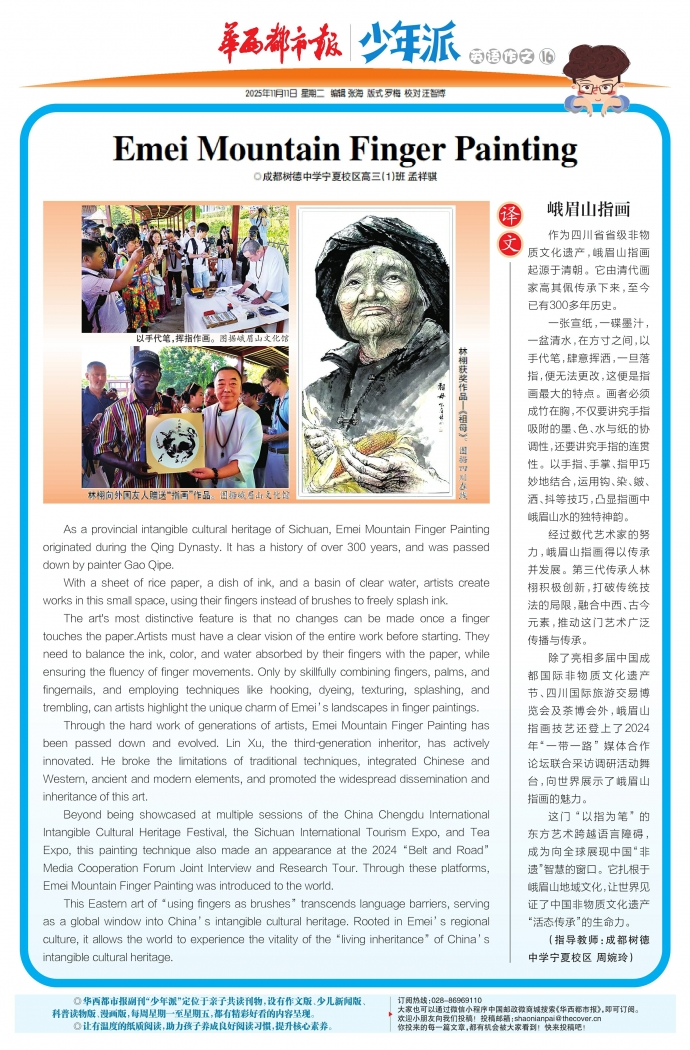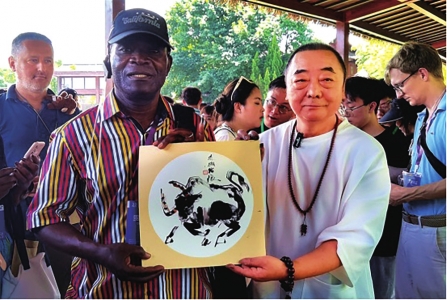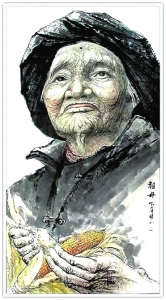Emei Mountain Finger Painting
以手代笔,挥指作画。图据峨眉山文化馆
林栩向外国友人赠送“指画”作品。图据峨眉山文化馆
林栩获奖作品—《祖母》。图据四川在线
◎成都树德中学宁夏校区高三(1)班 孟祥骐
As a provincial intangible cultural heritage of Sichuan, Emei Mountain Finger Painting originated during the Qing Dynasty. It has a history of over 300 years, and was passed down by painter Gao Qipe.
With a sheet of rice paper, a dish of ink, and a basin of clear water, artists create works in this small space, using their fingers instead of brushes to freely splash ink.
The art's most distinctive feature is that no changes can be made once a finger touches the paper.Artists must have a clear vision of the entire work before starting. They need to balance the ink, color, and water absorbed by their fingers with the paper, while ensuring the fluency of finger movements. Only by skillfully combining fingers, palms, and fingernails, and employing techniques like hooking, dyeing, texturing, splashing, and trembling, can artists highlight the unique charm of Emei’s landscapes in finger paintings.
Through the hard work of generations of artists, Emei Mountain Finger Painting has been passed down and evolved. Lin Xu, the third-generation inheritor, has actively innovated. He broke the limitations of traditional techniques, integrated Chinese and Western, ancient and modern elements, and promoted the widespread dissemination and inheritance of this art.
Beyond being showcased at multiple sessions of the China Chengdu International Intangible Cultural Heritage Festival, the Sichuan International Tourism Expo, and Tea Expo, this painting technique also made an appearance at the 2024“Belt and Road”Media Cooperation Forum Joint Interview and Research Tour. Through these platforms, Emei Mountain Finger Painting was introduced to the world.
This Eastern art of“using fingers as brushes”transcends language barriers, serving as a global window into China’s intangible cultural heritage. Rooted in Emei’s regional culture, it allows the world to experience the vitality of the“living inheritance”of China’s intangible cultural heritage.
译文
峨眉山指画
作为四川省省级非物质文化遗产,峨眉山指画起源于清朝。它由清代画家高其佩传承下来,至今已有300多年历史。
一张宣纸,一碟墨汁,一盆清水,在方寸之间,以手代笔,肆意挥洒,一旦落指,便无法更改,这便是指画最大的特点。画者必须成竹在胸,不仅要讲究手指吸附的墨、色、水与纸的协调性,还要讲究手指的连贯性。以手指、手掌、指甲巧妙地结合,运用钩、染、皴、洒、抖等技巧,凸显指画中峨眉山水的独特神韵。
经过数代艺术家的努力,峨眉山指画得以传承并发展。第三代传承人林栩积极创新,打破传统技法的局限,融合中西、古今元素,推动这门艺术广泛传播与传承。
除了亮相多届中国成都国际非物质文化遗产节、四川国际旅游交易博览会及茶博会外,峨眉山指画技艺还登上了2024年“一带一路”媒体合作论坛联合采访调研活动舞台,向世界展示了峨眉山指画的魅力。
这门“以指为笔”的东方艺术跨越语言障碍,成为向全球展现中国“非遗”智慧的窗口。它扎根于峨眉山地域文化,让世界见证了中国非物质文化遗产“活态传承”的生命力。
(指导教师:成都树德中学宁夏校区 周婉玲)




